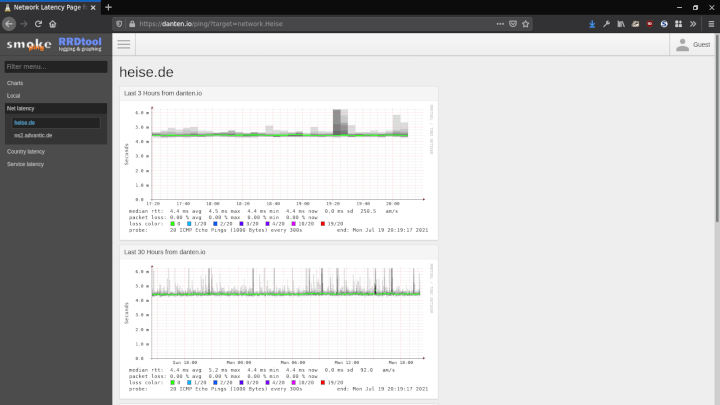SmokePing: Track Your Network Latency
Track Your Network Latency. Display Nice Graphs. Get Downtime Alerts.

Let me introduce you to SmokePing, a nice little tool to keep track of your network latency which comes with a responsive web-based UI as well as an alert system.
SmokePing Network Latency Tracker
SmokePing helps you to probe a list of servers, store the corresponding data using RRDtool, and generate some nice statistical charts based on the output.
SmokePing consists of two parts:
You’ll have the SmokePing daemon that runs in the background and is pinging and collecting data at your set intervals, as well as the SmokePing front-end interface that then displays the collected data in the form of nice looking graphs.
The SmokePings alert system is really useful, and can be configured to send alerts via email when defined latency thresholds are reached.
Here are some of SmokePings core features:
- Best of breed latency visualisation.
- Interactive graph explorer.
- Wide range of latency measurement plugins.
- Master/Slave System for distributed measurement.
- Highly configurable alerting system.
- Live Latency Charts with the most ‘interesting’ graphs.
- Free and OpenSource Software written in Perl by the creator of MRTG and RRDtool.
– SmokePing
Install SmokePing - The Debian Way
As usual, here comes the easy part:
$ apt install apache2 curl echoping fping hping3 htop ipcalc jq lftp lynx mlocate mtr nmap pwgen rsync sipcalc smokeping tmate tree tshark unzip vnstat wget zip
You’ll note that we’re pulling some additional packages, chances are that you’ve got some of these already installed. So let’s pull ‘em in so we can proceed with the configuration.
SmokePing Configuration on Debian 10 Buster
You’ll need a running Apache with mod_fcgi - or alternatively Nginx with fcgiwrap - and SmokePing’s gonna set up its config in /etc/apache2/conf-enabled/smokeping.conf - here’s how mine looks like:
|
|
Because I prefer to install SmokePing into a subfolder called ping, as you can see from the Aliases above, I’ll need to adjust the pathnames accordingly in /etc/smokeping/config.d/pathnames:
sendmail = /usr/sbin/sendmail
imgcache = /var/cache/smokeping/images
imgurl = ../ping/images
datadir = /var/lib/smokeping
piddir = /var/run/smokeping
smokemail = /etc/smokeping/smokemail
tmail = /etc/smokeping/tmail
dyndir = /var/lib/smokeping/__cgi
General SmokePing Configuration
Now let’s move on to the main Configuration in /etc/smokeping/config.d/General:
*** General ***
owner = Daniel Tenningås
contact = danten@localhost
mailhost = localhost
# NOTE: do not put the Image Cache below cgi-bin
# since all files under cgi-bin will be executed ... this is not
# good for images.
cgiurl = http://some.url/smokeping.cgi
# specify this to get syslog logging
syslogfacility = local0
# each probe is now run in its own process
# disable this to revert to the old behaviour
# concurrentprobes = no
@include /etc/smokeping/config.d/pathnames
Defining Your Probes - Your Methods of Probing
Then we’ll specify how we want to conduct our probes in /etc/smokeping/config.d/Probes:
*** Probes ***
+ FPing
binary = /usr/bin/fping
packetsize = 1000
+ DNS
binary = /usr/bin/dig
lookup = heise.de
pings = 5
step = 180
Other methods of probing are also possible, such as SSH, EchoPing & cURL. Let’s stick with a simple FPing and a dig to probe DNS latency for time being.
Targets - The Machines You Probe
Now comes the fun part where we can play around a lot, we get to specify our targets in /etc/smokeping/config.d/Targets - here’s how that looks like on my box:
*** Targets ***
probe = FPing
menu = Top
title = Network Latency Grapher
remark = Welcome to the Network Latency Grapher aka my SmokePing implementation. \
Here you can learn more about the latency of the danten.io network.
+ Local
menu = Local
title = Local Network
++ LocalMachine
menu = Local Machine
title = This host
host = localhost
#alerts = someloss
+ network
menu = Net latency
title = Network latency (ICMP pings)
++ Heise
host = heise.de
++ Advantic
host = ns2.advantic.de
+ countries
menu = Country latency
title = Country latency, ICMP Pings
++ Europe
menu = Europe
title =European Connectivity
+++ Germany
menu = Germany
title = German Connectivity
#alerts = bigloss,someloss,startloss
++++ Heise
menu = Heise
title = Heise
host = www.heise.de
+++ Norway
menu = Norway
title = Norway latency
++++ NTNU
menu = NTNU
title = NTNU
host = www.ntnu.no
++++ NRK
menu = NRK
title = NRK
host = www.nrk.no
+++ UK
menu = UK
title = BBC
host = www.bbc.co.uk
+++ Switzerland
menu = Switzerland
title = CERN
host = cern.ch
++ USA
menu = North America
title =North American Connectivity
+++ MIT
menu = MIT
title = Massachusetts Institute of Technology Webserver
host = web.mit.edu
+ services
menu = Service latency
title = Service latency (DNS, HTTP)
++ DNS
probe = DNS
menu = DNS latency
title = Service latency (DNS)
+++ dns1
host = ns2.advantic.de
+++ dns2
host = 8.8.8.8
++ HTTP
menu = HTTP latency
title = Service latency (HTTP)
+++ www1
host = www.heise.de
+++ www2
host = danten.io
+++ www3
host = www.nrk.no
SmokePing Configuration Syntax
Each + character defines a section in the SmokePing hierarchy. Spaces are not allowed in the section names, and it’d be better to avoid period and forward slashes in these section names, as it seems the RRD files are stored under the data directory with the same exact names as the sections.
SmokePing is a powerful tool with many advanced configuration options. You can setup many different types of probes. You can setup a SmokePing chain of servers that can send their statistics and show you probes from other machines. You can also create your own custom probes in Perl.
Above configuration is only scratching at the surface of the many options SmokePing hides underneath its hood, but should be OK to get up running.
Visit my SmokePing to check out how that looks.
:wq